The Significance of Teaching and Assessment in Early Childhood
VerifiedAdded on 2022/09/26
|10
|2210
|27
Essay
AI Summary
This essay delves into the critical role of teaching and assessment in fostering young children's learning and development. It examines the significance of teaching, emphasizing the teacher's role in facilitating children's social, cognitive, physical, and emotional growth through lesson planning and activity engagement. The paper highlights the importance of assessment tools in making educational decisions and identifying learning differences. It then explores various pedagogical approaches, including constructivist, behaviorism, social constructivism, and liberationism, as well as assessment approaches such as open-ended instruction, inquiry learning, and cooperative learning. The essay also discusses contemporary teaching methods, such as oral communication and exploratory learning, and assessment methods like formative, summative, and norm-referenced assessments. The paper concludes by emphasizing the importance of professional and ethical conduct for teachers in providing quality education and nurturing young children with care, commitment, and affection.
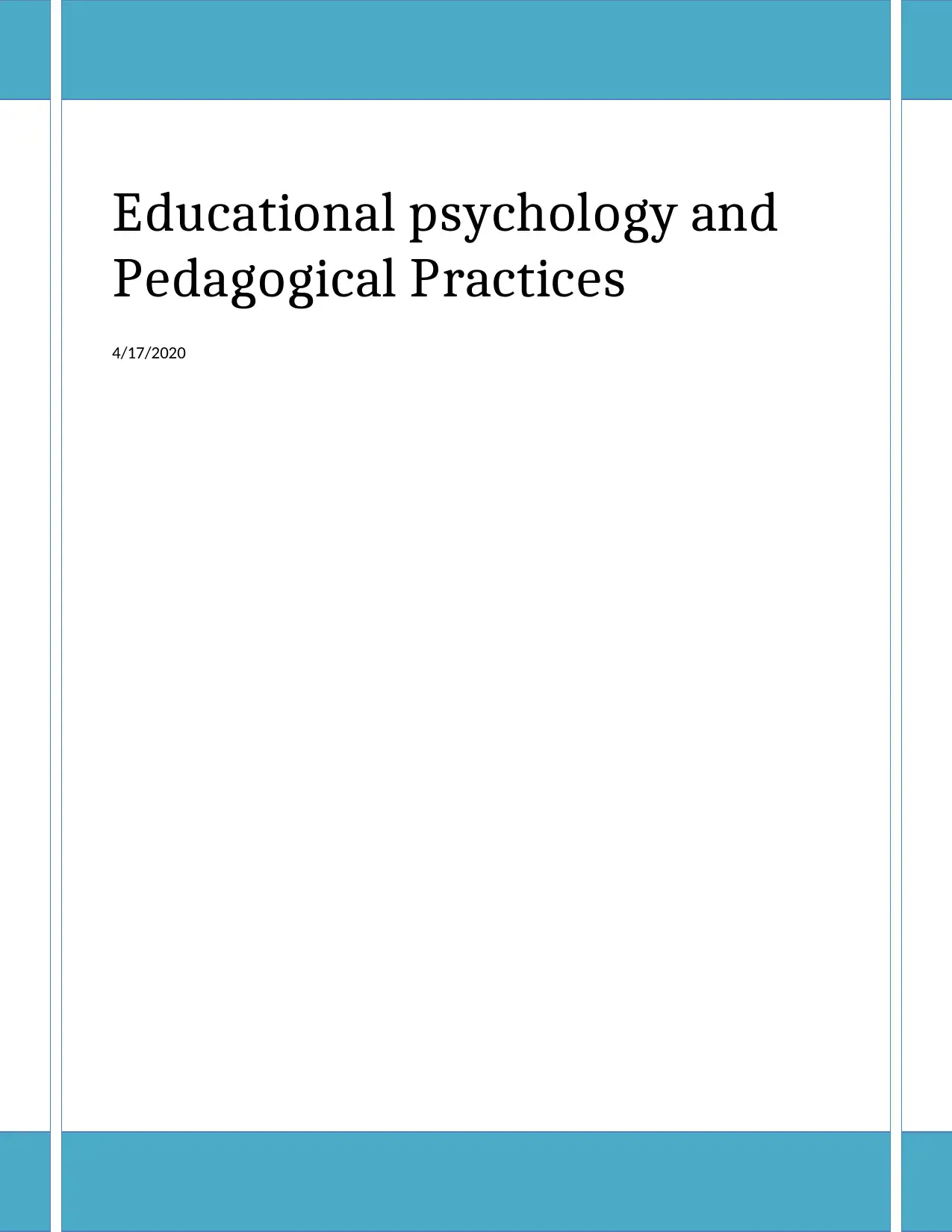
Educational psychology and
Pedagogical Practices
4/17/2020
Pedagogical Practices
4/17/2020
Paraphrase This Document
Need a fresh take? Get an instant paraphrase of this document with our AI Paraphraser
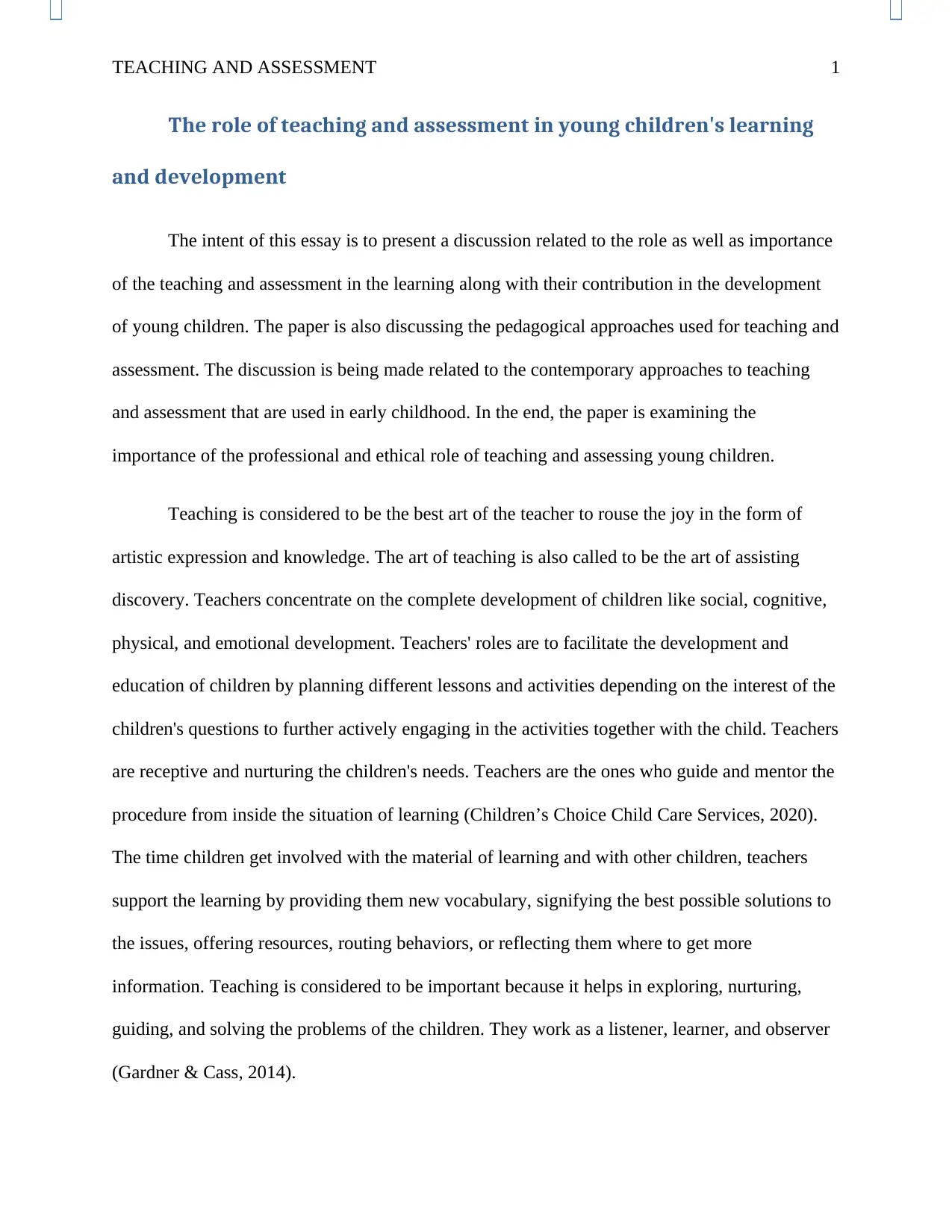
TEACHING AND ASSESSMENT 1
The role of teaching and assessment in young children's learning
and development
The intent of this essay is to present a discussion related to the role as well as importance
of the teaching and assessment in the learning along with their contribution in the development
of young children. The paper is also discussing the pedagogical approaches used for teaching and
assessment. The discussion is being made related to the contemporary approaches to teaching
and assessment that are used in early childhood. In the end, the paper is examining the
importance of the professional and ethical role of teaching and assessing young children.
Teaching is considered to be the best art of the teacher to rouse the joy in the form of
artistic expression and knowledge. The art of teaching is also called to be the art of assisting
discovery. Teachers concentrate on the complete development of children like social, cognitive,
physical, and emotional development. Teachers' roles are to facilitate the development and
education of children by planning different lessons and activities depending on the interest of the
children's questions to further actively engaging in the activities together with the child. Teachers
are receptive and nurturing the children's needs. Teachers are the ones who guide and mentor the
procedure from inside the situation of learning (Children’s Choice Child Care Services, 2020).
The time children get involved with the material of learning and with other children, teachers
support the learning by providing them new vocabulary, signifying the best possible solutions to
the issues, offering resources, routing behaviors, or reflecting them where to get more
information. Teaching is considered to be important because it helps in exploring, nurturing,
guiding, and solving the problems of the children. They work as a listener, learner, and observer
(Gardner & Cass, 2014).
The role of teaching and assessment in young children's learning
and development
The intent of this essay is to present a discussion related to the role as well as importance
of the teaching and assessment in the learning along with their contribution in the development
of young children. The paper is also discussing the pedagogical approaches used for teaching and
assessment. The discussion is being made related to the contemporary approaches to teaching
and assessment that are used in early childhood. In the end, the paper is examining the
importance of the professional and ethical role of teaching and assessing young children.
Teaching is considered to be the best art of the teacher to rouse the joy in the form of
artistic expression and knowledge. The art of teaching is also called to be the art of assisting
discovery. Teachers concentrate on the complete development of children like social, cognitive,
physical, and emotional development. Teachers' roles are to facilitate the development and
education of children by planning different lessons and activities depending on the interest of the
children's questions to further actively engaging in the activities together with the child. Teachers
are receptive and nurturing the children's needs. Teachers are the ones who guide and mentor the
procedure from inside the situation of learning (Children’s Choice Child Care Services, 2020).
The time children get involved with the material of learning and with other children, teachers
support the learning by providing them new vocabulary, signifying the best possible solutions to
the issues, offering resources, routing behaviors, or reflecting them where to get more
information. Teaching is considered to be important because it helps in exploring, nurturing,
guiding, and solving the problems of the children. They work as a listener, learner, and observer
(Gardner & Cass, 2014).
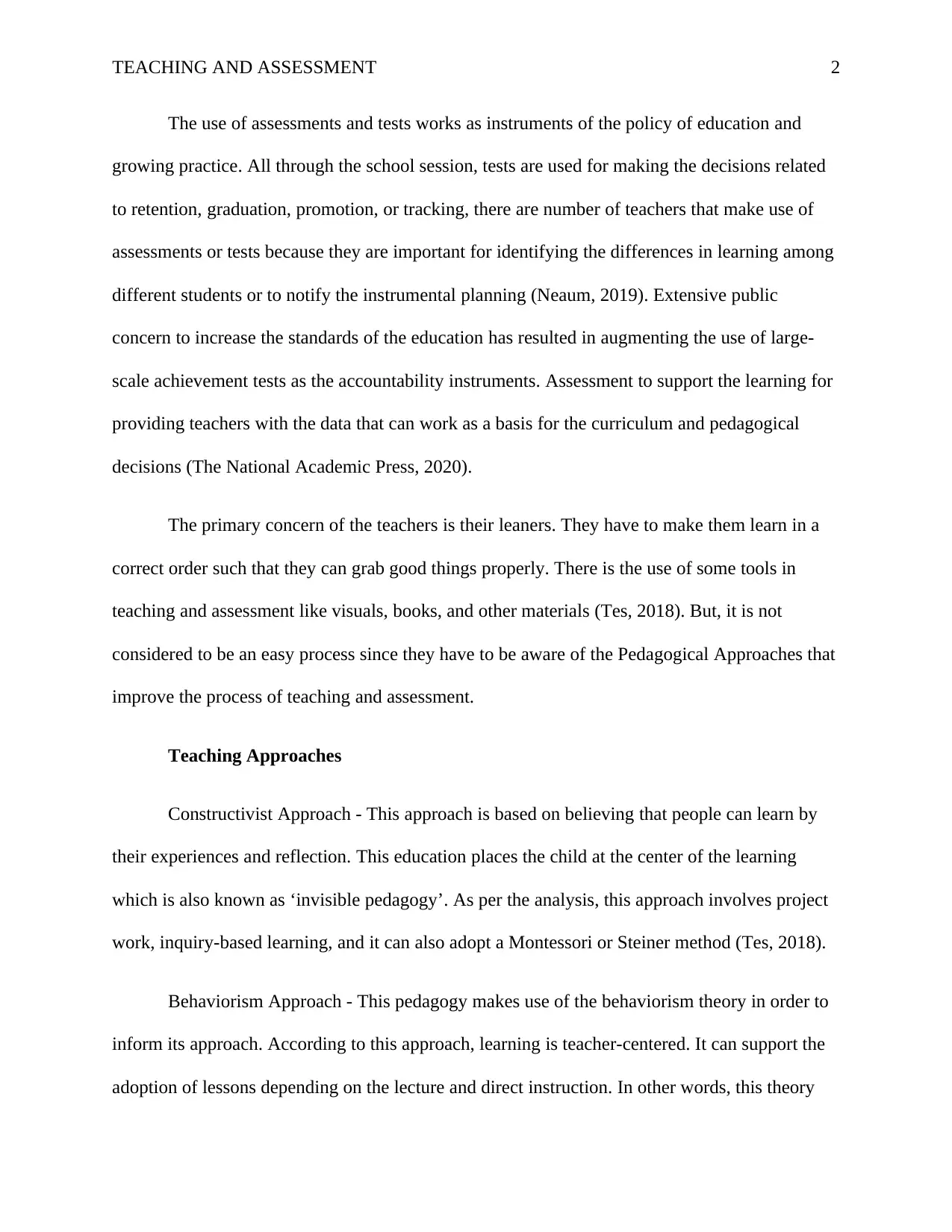
TEACHING AND ASSESSMENT 2
The use of assessments and tests works as instruments of the policy of education and
growing practice. All through the school session, tests are used for making the decisions related
to retention, graduation, promotion, or tracking, there are number of teachers that make use of
assessments or tests because they are important for identifying the differences in learning among
different students or to notify the instrumental planning (Neaum, 2019). Extensive public
concern to increase the standards of the education has resulted in augmenting the use of large-
scale achievement tests as the accountability instruments. Assessment to support the learning for
providing teachers with the data that can work as a basis for the curriculum and pedagogical
decisions (The National Academic Press, 2020).
The primary concern of the teachers is their leaners. They have to make them learn in a
correct order such that they can grab good things properly. There is the use of some tools in
teaching and assessment like visuals, books, and other materials (Tes, 2018). But, it is not
considered to be an easy process since they have to be aware of the Pedagogical Approaches that
improve the process of teaching and assessment.
Teaching Approaches
Constructivist Approach - This approach is based on believing that people can learn by
their experiences and reflection. This education places the child at the center of the learning
which is also known as ‘invisible pedagogy’. As per the analysis, this approach involves project
work, inquiry-based learning, and it can also adopt a Montessori or Steiner method (Tes, 2018).
Behaviorism Approach - This pedagogy makes use of the behaviorism theory in order to
inform its approach. According to this approach, learning is teacher-centered. It can support the
adoption of lessons depending on the lecture and direct instruction. In other words, this theory
The use of assessments and tests works as instruments of the policy of education and
growing practice. All through the school session, tests are used for making the decisions related
to retention, graduation, promotion, or tracking, there are number of teachers that make use of
assessments or tests because they are important for identifying the differences in learning among
different students or to notify the instrumental planning (Neaum, 2019). Extensive public
concern to increase the standards of the education has resulted in augmenting the use of large-
scale achievement tests as the accountability instruments. Assessment to support the learning for
providing teachers with the data that can work as a basis for the curriculum and pedagogical
decisions (The National Academic Press, 2020).
The primary concern of the teachers is their leaners. They have to make them learn in a
correct order such that they can grab good things properly. There is the use of some tools in
teaching and assessment like visuals, books, and other materials (Tes, 2018). But, it is not
considered to be an easy process since they have to be aware of the Pedagogical Approaches that
improve the process of teaching and assessment.
Teaching Approaches
Constructivist Approach - This approach is based on believing that people can learn by
their experiences and reflection. This education places the child at the center of the learning
which is also known as ‘invisible pedagogy’. As per the analysis, this approach involves project
work, inquiry-based learning, and it can also adopt a Montessori or Steiner method (Tes, 2018).
Behaviorism Approach - This pedagogy makes use of the behaviorism theory in order to
inform its approach. According to this approach, learning is teacher-centered. It can support the
adoption of lessons depending on the lecture and direct instruction. In other words, this theory
⊘ This is a preview!⊘
Do you want full access?
Subscribe today to unlock all pages.

Trusted by 1+ million students worldwide
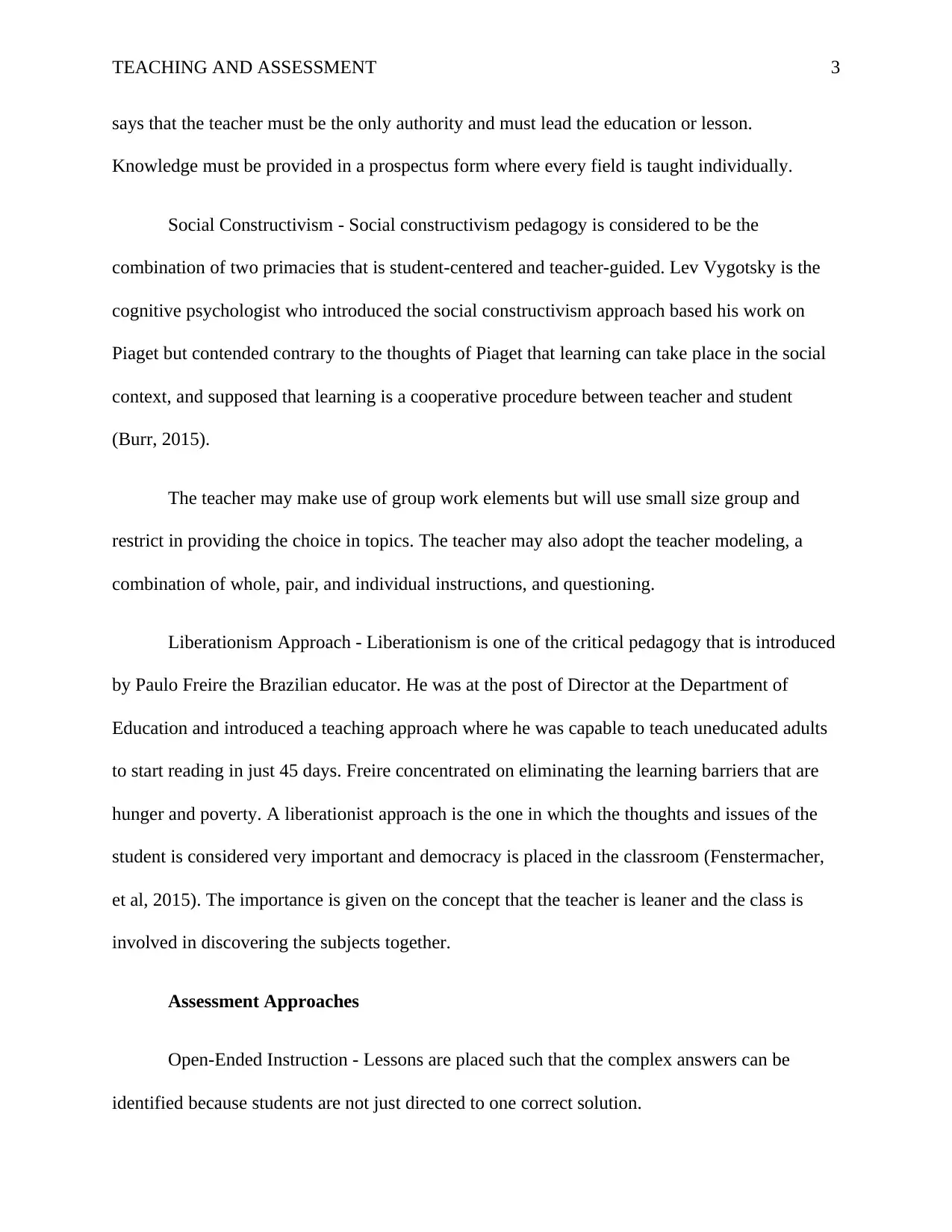
TEACHING AND ASSESSMENT 3
says that the teacher must be the only authority and must lead the education or lesson.
Knowledge must be provided in a prospectus form where every field is taught individually.
Social Constructivism - Social constructivism pedagogy is considered to be the
combination of two primacies that is student-centered and teacher-guided. Lev Vygotsky is the
cognitive psychologist who introduced the social constructivism approach based his work on
Piaget but contended contrary to the thoughts of Piaget that learning can take place in the social
context, and supposed that learning is a cooperative procedure between teacher and student
(Burr, 2015).
The teacher may make use of group work elements but will use small size group and
restrict in providing the choice in topics. The teacher may also adopt the teacher modeling, a
combination of whole, pair, and individual instructions, and questioning.
Liberationism Approach - Liberationism is one of the critical pedagogy that is introduced
by Paulo Freire the Brazilian educator. He was at the post of Director at the Department of
Education and introduced a teaching approach where he was capable to teach uneducated adults
to start reading in just 45 days. Freire concentrated on eliminating the learning barriers that are
hunger and poverty. A liberationist approach is the one in which the thoughts and issues of the
student is considered very important and democracy is placed in the classroom (Fenstermacher,
et al, 2015). The importance is given on the concept that the teacher is leaner and the class is
involved in discovering the subjects together.
Assessment Approaches
Open-Ended Instruction - Lessons are placed such that the complex answers can be
identified because students are not just directed to one correct solution.
says that the teacher must be the only authority and must lead the education or lesson.
Knowledge must be provided in a prospectus form where every field is taught individually.
Social Constructivism - Social constructivism pedagogy is considered to be the
combination of two primacies that is student-centered and teacher-guided. Lev Vygotsky is the
cognitive psychologist who introduced the social constructivism approach based his work on
Piaget but contended contrary to the thoughts of Piaget that learning can take place in the social
context, and supposed that learning is a cooperative procedure between teacher and student
(Burr, 2015).
The teacher may make use of group work elements but will use small size group and
restrict in providing the choice in topics. The teacher may also adopt the teacher modeling, a
combination of whole, pair, and individual instructions, and questioning.
Liberationism Approach - Liberationism is one of the critical pedagogy that is introduced
by Paulo Freire the Brazilian educator. He was at the post of Director at the Department of
Education and introduced a teaching approach where he was capable to teach uneducated adults
to start reading in just 45 days. Freire concentrated on eliminating the learning barriers that are
hunger and poverty. A liberationist approach is the one in which the thoughts and issues of the
student is considered very important and democracy is placed in the classroom (Fenstermacher,
et al, 2015). The importance is given on the concept that the teacher is leaner and the class is
involved in discovering the subjects together.
Assessment Approaches
Open-Ended Instruction - Lessons are placed such that the complex answers can be
identified because students are not just directed to one correct solution.
Paraphrase This Document
Need a fresh take? Get an instant paraphrase of this document with our AI Paraphraser
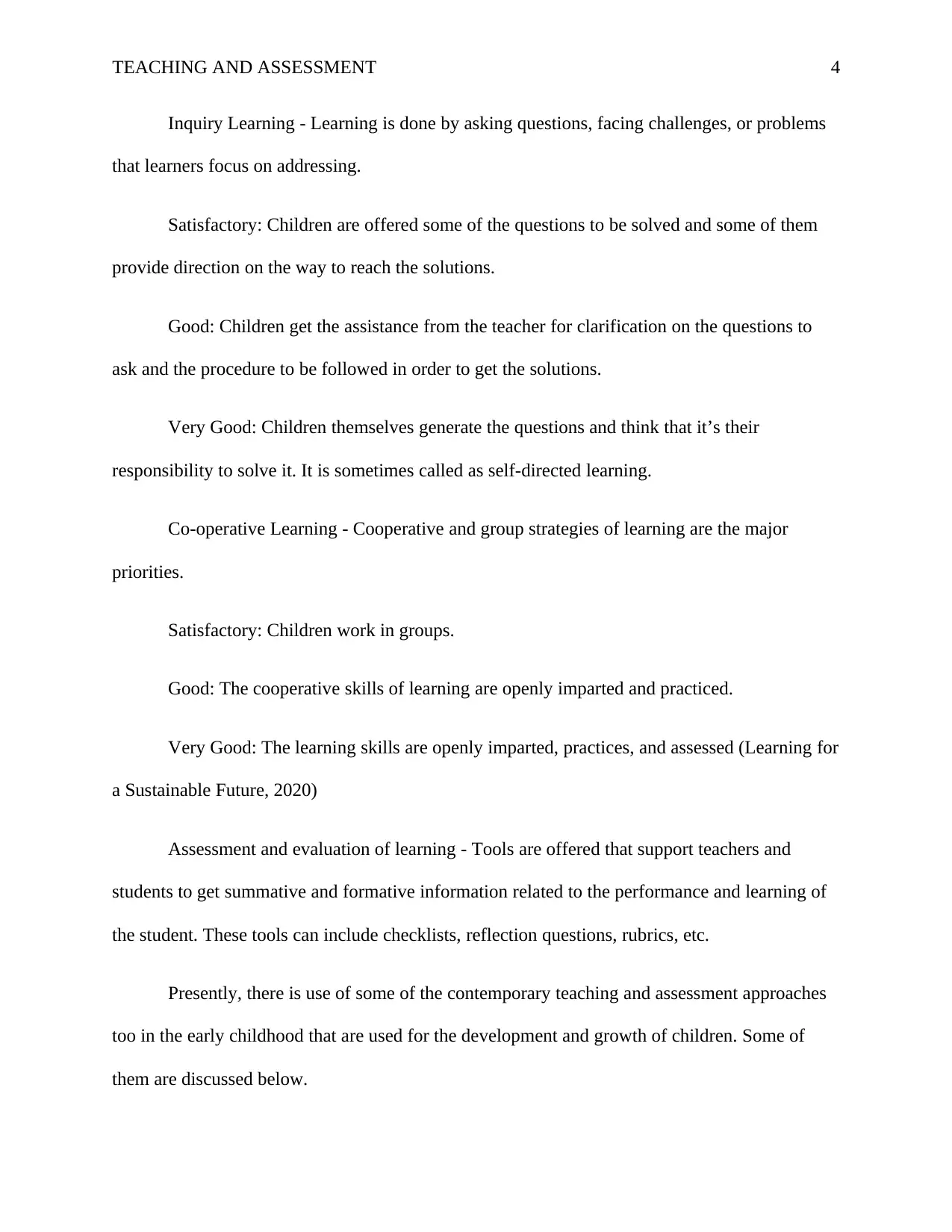
TEACHING AND ASSESSMENT 4
Inquiry Learning - Learning is done by asking questions, facing challenges, or problems
that learners focus on addressing.
Satisfactory: Children are offered some of the questions to be solved and some of them
provide direction on the way to reach the solutions.
Good: Children get the assistance from the teacher for clarification on the questions to
ask and the procedure to be followed in order to get the solutions.
Very Good: Children themselves generate the questions and think that it’s their
responsibility to solve it. It is sometimes called as self-directed learning.
Co-operative Learning - Cooperative and group strategies of learning are the major
priorities.
Satisfactory: Children work in groups.
Good: The cooperative skills of learning are openly imparted and practiced.
Very Good: The learning skills are openly imparted, practices, and assessed (Learning for
a Sustainable Future, 2020)
Assessment and evaluation of learning - Tools are offered that support teachers and
students to get summative and formative information related to the performance and learning of
the student. These tools can include checklists, reflection questions, rubrics, etc.
Presently, there is use of some of the contemporary teaching and assessment approaches
too in the early childhood that are used for the development and growth of children. Some of
them are discussed below.
Inquiry Learning - Learning is done by asking questions, facing challenges, or problems
that learners focus on addressing.
Satisfactory: Children are offered some of the questions to be solved and some of them
provide direction on the way to reach the solutions.
Good: Children get the assistance from the teacher for clarification on the questions to
ask and the procedure to be followed in order to get the solutions.
Very Good: Children themselves generate the questions and think that it’s their
responsibility to solve it. It is sometimes called as self-directed learning.
Co-operative Learning - Cooperative and group strategies of learning are the major
priorities.
Satisfactory: Children work in groups.
Good: The cooperative skills of learning are openly imparted and practiced.
Very Good: The learning skills are openly imparted, practices, and assessed (Learning for
a Sustainable Future, 2020)
Assessment and evaluation of learning - Tools are offered that support teachers and
students to get summative and formative information related to the performance and learning of
the student. These tools can include checklists, reflection questions, rubrics, etc.
Presently, there is use of some of the contemporary teaching and assessment approaches
too in the early childhood that are used for the development and growth of children. Some of
them are discussed below.
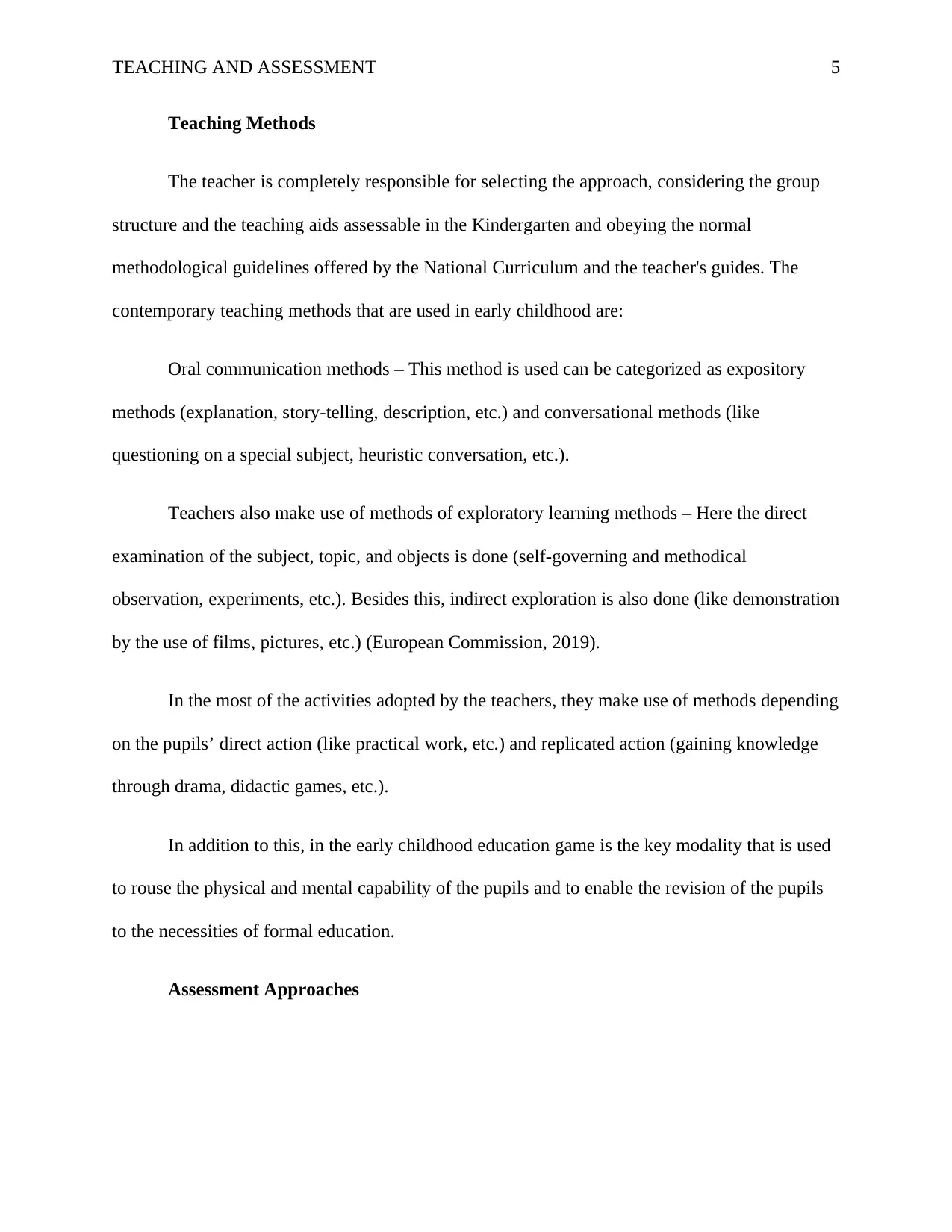
TEACHING AND ASSESSMENT 5
Teaching Methods
The teacher is completely responsible for selecting the approach, considering the group
structure and the teaching aids assessable in the Kindergarten and obeying the normal
methodological guidelines offered by the National Curriculum and the teacher's guides. The
contemporary teaching methods that are used in early childhood are:
Oral communication methods – This method is used can be categorized as expository
methods (explanation, story-telling, description, etc.) and conversational methods (like
questioning on a special subject, heuristic conversation, etc.).
Teachers also make use of methods of exploratory learning methods – Here the direct
examination of the subject, topic, and objects is done (self-governing and methodical
observation, experiments, etc.). Besides this, indirect exploration is also done (like demonstration
by the use of films, pictures, etc.) (European Commission, 2019).
In the most of the activities adopted by the teachers, they make use of methods depending
on the pupils’ direct action (like practical work, etc.) and replicated action (gaining knowledge
through drama, didactic games, etc.).
In addition to this, in the early childhood education game is the key modality that is used
to rouse the physical and mental capability of the pupils and to enable the revision of the pupils
to the necessities of formal education.
Assessment Approaches
Teaching Methods
The teacher is completely responsible for selecting the approach, considering the group
structure and the teaching aids assessable in the Kindergarten and obeying the normal
methodological guidelines offered by the National Curriculum and the teacher's guides. The
contemporary teaching methods that are used in early childhood are:
Oral communication methods – This method is used can be categorized as expository
methods (explanation, story-telling, description, etc.) and conversational methods (like
questioning on a special subject, heuristic conversation, etc.).
Teachers also make use of methods of exploratory learning methods – Here the direct
examination of the subject, topic, and objects is done (self-governing and methodical
observation, experiments, etc.). Besides this, indirect exploration is also done (like demonstration
by the use of films, pictures, etc.) (European Commission, 2019).
In the most of the activities adopted by the teachers, they make use of methods depending
on the pupils’ direct action (like practical work, etc.) and replicated action (gaining knowledge
through drama, didactic games, etc.).
In addition to this, in the early childhood education game is the key modality that is used
to rouse the physical and mental capability of the pupils and to enable the revision of the pupils
to the necessities of formal education.
Assessment Approaches
⊘ This is a preview!⊘
Do you want full access?
Subscribe today to unlock all pages.

Trusted by 1+ million students worldwide
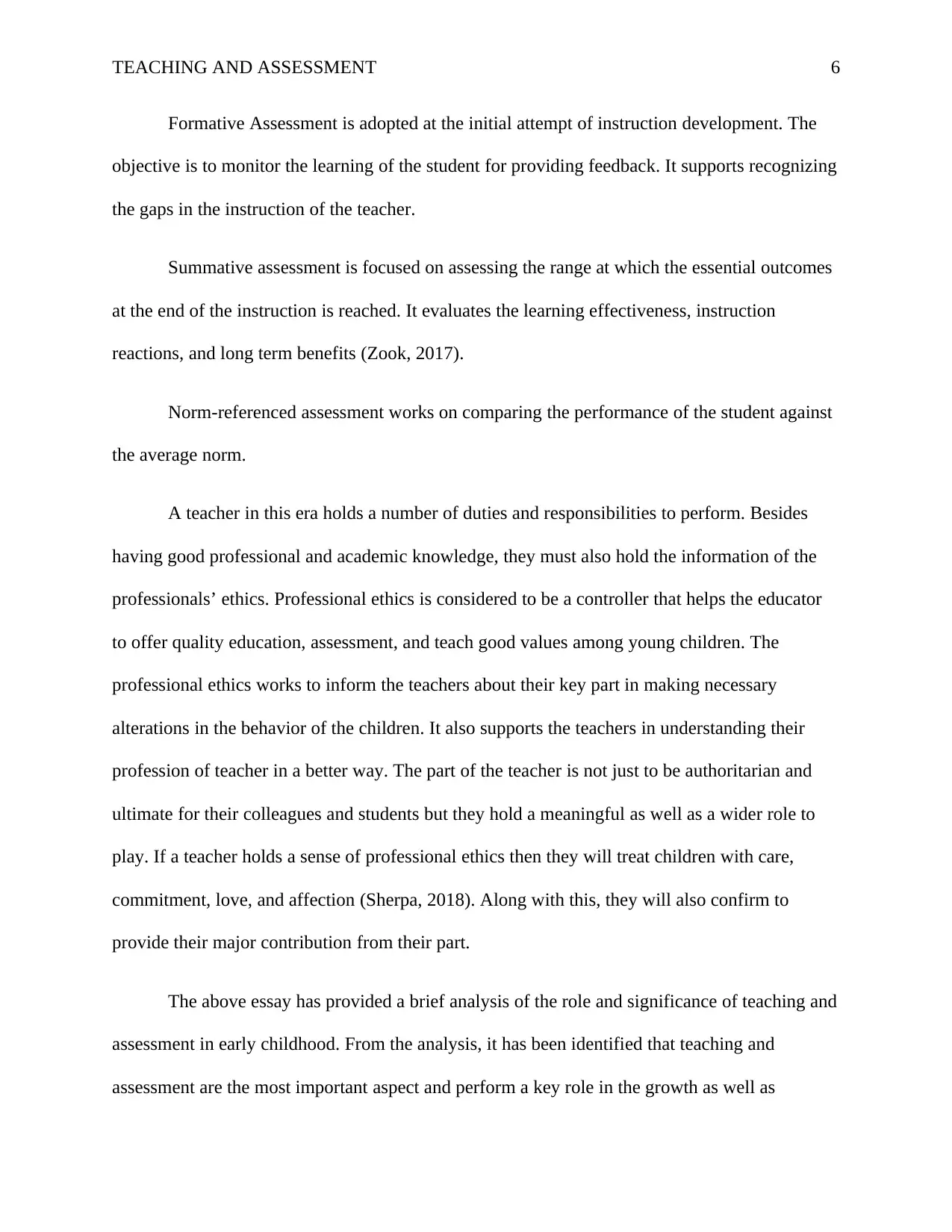
TEACHING AND ASSESSMENT 6
Formative Assessment is adopted at the initial attempt of instruction development. The
objective is to monitor the learning of the student for providing feedback. It supports recognizing
the gaps in the instruction of the teacher.
Summative assessment is focused on assessing the range at which the essential outcomes
at the end of the instruction is reached. It evaluates the learning effectiveness, instruction
reactions, and long term benefits (Zook, 2017).
Norm-referenced assessment works on comparing the performance of the student against
the average norm.
A teacher in this era holds a number of duties and responsibilities to perform. Besides
having good professional and academic knowledge, they must also hold the information of the
professionals’ ethics. Professional ethics is considered to be a controller that helps the educator
to offer quality education, assessment, and teach good values among young children. The
professional ethics works to inform the teachers about their key part in making necessary
alterations in the behavior of the children. It also supports the teachers in understanding their
profession of teacher in a better way. The part of the teacher is not just to be authoritarian and
ultimate for their colleagues and students but they hold a meaningful as well as a wider role to
play. If a teacher holds a sense of professional ethics then they will treat children with care,
commitment, love, and affection (Sherpa, 2018). Along with this, they will also confirm to
provide their major contribution from their part.
The above essay has provided a brief analysis of the role and significance of teaching and
assessment in early childhood. From the analysis, it has been identified that teaching and
assessment are the most important aspect and perform a key role in the growth as well as
Formative Assessment is adopted at the initial attempt of instruction development. The
objective is to monitor the learning of the student for providing feedback. It supports recognizing
the gaps in the instruction of the teacher.
Summative assessment is focused on assessing the range at which the essential outcomes
at the end of the instruction is reached. It evaluates the learning effectiveness, instruction
reactions, and long term benefits (Zook, 2017).
Norm-referenced assessment works on comparing the performance of the student against
the average norm.
A teacher in this era holds a number of duties and responsibilities to perform. Besides
having good professional and academic knowledge, they must also hold the information of the
professionals’ ethics. Professional ethics is considered to be a controller that helps the educator
to offer quality education, assessment, and teach good values among young children. The
professional ethics works to inform the teachers about their key part in making necessary
alterations in the behavior of the children. It also supports the teachers in understanding their
profession of teacher in a better way. The part of the teacher is not just to be authoritarian and
ultimate for their colleagues and students but they hold a meaningful as well as a wider role to
play. If a teacher holds a sense of professional ethics then they will treat children with care,
commitment, love, and affection (Sherpa, 2018). Along with this, they will also confirm to
provide their major contribution from their part.
The above essay has provided a brief analysis of the role and significance of teaching and
assessment in early childhood. From the analysis, it has been identified that teaching and
assessment are the most important aspect and perform a key role in the growth as well as
Paraphrase This Document
Need a fresh take? Get an instant paraphrase of this document with our AI Paraphraser
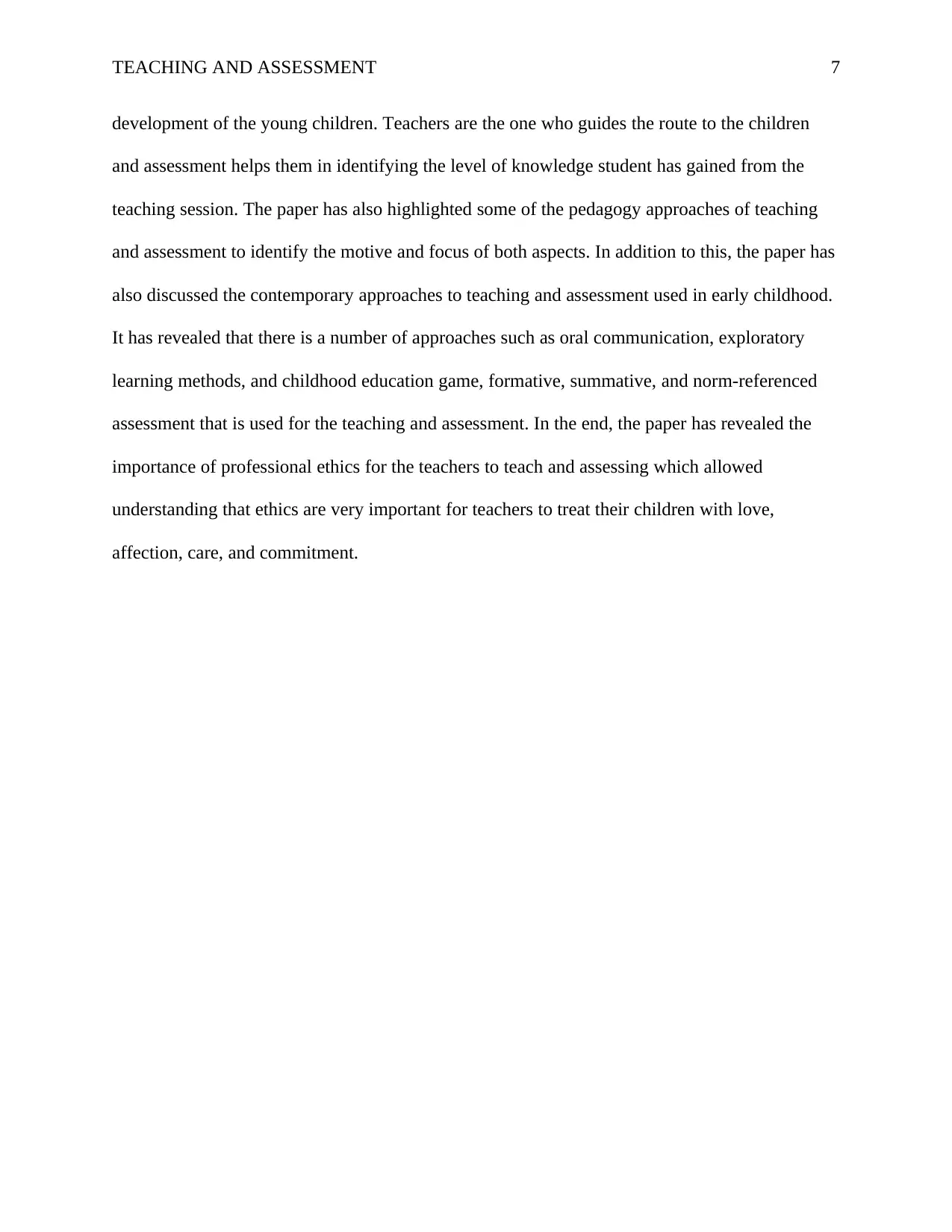
TEACHING AND ASSESSMENT 7
development of the young children. Teachers are the one who guides the route to the children
and assessment helps them in identifying the level of knowledge student has gained from the
teaching session. The paper has also highlighted some of the pedagogy approaches of teaching
and assessment to identify the motive and focus of both aspects. In addition to this, the paper has
also discussed the contemporary approaches to teaching and assessment used in early childhood.
It has revealed that there is a number of approaches such as oral communication, exploratory
learning methods, and childhood education game, formative, summative, and norm-referenced
assessment that is used for the teaching and assessment. In the end, the paper has revealed the
importance of professional ethics for the teachers to teach and assessing which allowed
understanding that ethics are very important for teachers to treat their children with love,
affection, care, and commitment.
development of the young children. Teachers are the one who guides the route to the children
and assessment helps them in identifying the level of knowledge student has gained from the
teaching session. The paper has also highlighted some of the pedagogy approaches of teaching
and assessment to identify the motive and focus of both aspects. In addition to this, the paper has
also discussed the contemporary approaches to teaching and assessment used in early childhood.
It has revealed that there is a number of approaches such as oral communication, exploratory
learning methods, and childhood education game, formative, summative, and norm-referenced
assessment that is used for the teaching and assessment. In the end, the paper has revealed the
importance of professional ethics for the teachers to teach and assessing which allowed
understanding that ethics are very important for teachers to treat their children with love,
affection, care, and commitment.
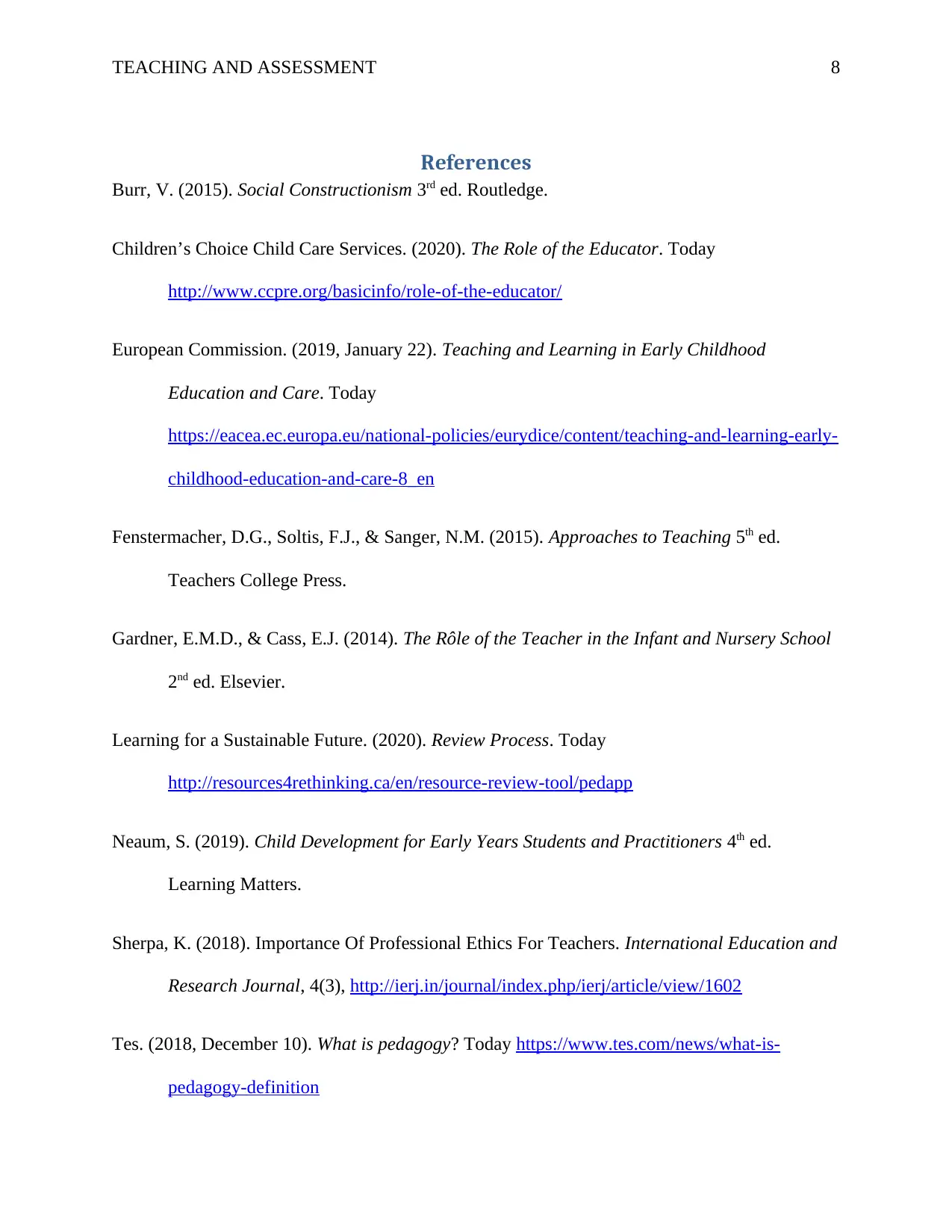
TEACHING AND ASSESSMENT 8
References
Burr, V. (2015). Social Constructionism 3rd ed. Routledge.
Children’s Choice Child Care Services. (2020). The Role of the Educator. Today
http://www.ccpre.org/basicinfo/role-of-the-educator/
European Commission. (2019, January 22). Teaching and Learning in Early Childhood
Education and Care. Today
https://eacea.ec.europa.eu/national-policies/eurydice/content/teaching-and-learning-early-
childhood-education-and-care-8_en
Fenstermacher, D.G., Soltis, F.J., & Sanger, N.M. (2015). Approaches to Teaching 5th ed.
Teachers College Press.
Gardner, E.M.D., & Cass, E.J. (2014). The Rôle of the Teacher in the Infant and Nursery School
2nd ed. Elsevier.
Learning for a Sustainable Future. (2020). Review Process. Today
http://resources4rethinking.ca/en/resource-review-tool/pedapp
Neaum, S. (2019). Child Development for Early Years Students and Practitioners 4th ed.
Learning Matters.
Sherpa, K. (2018). Importance Of Professional Ethics For Teachers. International Education and
Research Journal, 4(3), http://ierj.in/journal/index.php/ierj/article/view/1602
Tes. (2018, December 10). What is pedagogy? Today https://www.tes.com/news/what-is-
pedagogy-definition
References
Burr, V. (2015). Social Constructionism 3rd ed. Routledge.
Children’s Choice Child Care Services. (2020). The Role of the Educator. Today
http://www.ccpre.org/basicinfo/role-of-the-educator/
European Commission. (2019, January 22). Teaching and Learning in Early Childhood
Education and Care. Today
https://eacea.ec.europa.eu/national-policies/eurydice/content/teaching-and-learning-early-
childhood-education-and-care-8_en
Fenstermacher, D.G., Soltis, F.J., & Sanger, N.M. (2015). Approaches to Teaching 5th ed.
Teachers College Press.
Gardner, E.M.D., & Cass, E.J. (2014). The Rôle of the Teacher in the Infant and Nursery School
2nd ed. Elsevier.
Learning for a Sustainable Future. (2020). Review Process. Today
http://resources4rethinking.ca/en/resource-review-tool/pedapp
Neaum, S. (2019). Child Development for Early Years Students and Practitioners 4th ed.
Learning Matters.
Sherpa, K. (2018). Importance Of Professional Ethics For Teachers. International Education and
Research Journal, 4(3), http://ierj.in/journal/index.php/ierj/article/view/1602
Tes. (2018, December 10). What is pedagogy? Today https://www.tes.com/news/what-is-
pedagogy-definition
⊘ This is a preview!⊘
Do you want full access?
Subscribe today to unlock all pages.

Trusted by 1+ million students worldwide
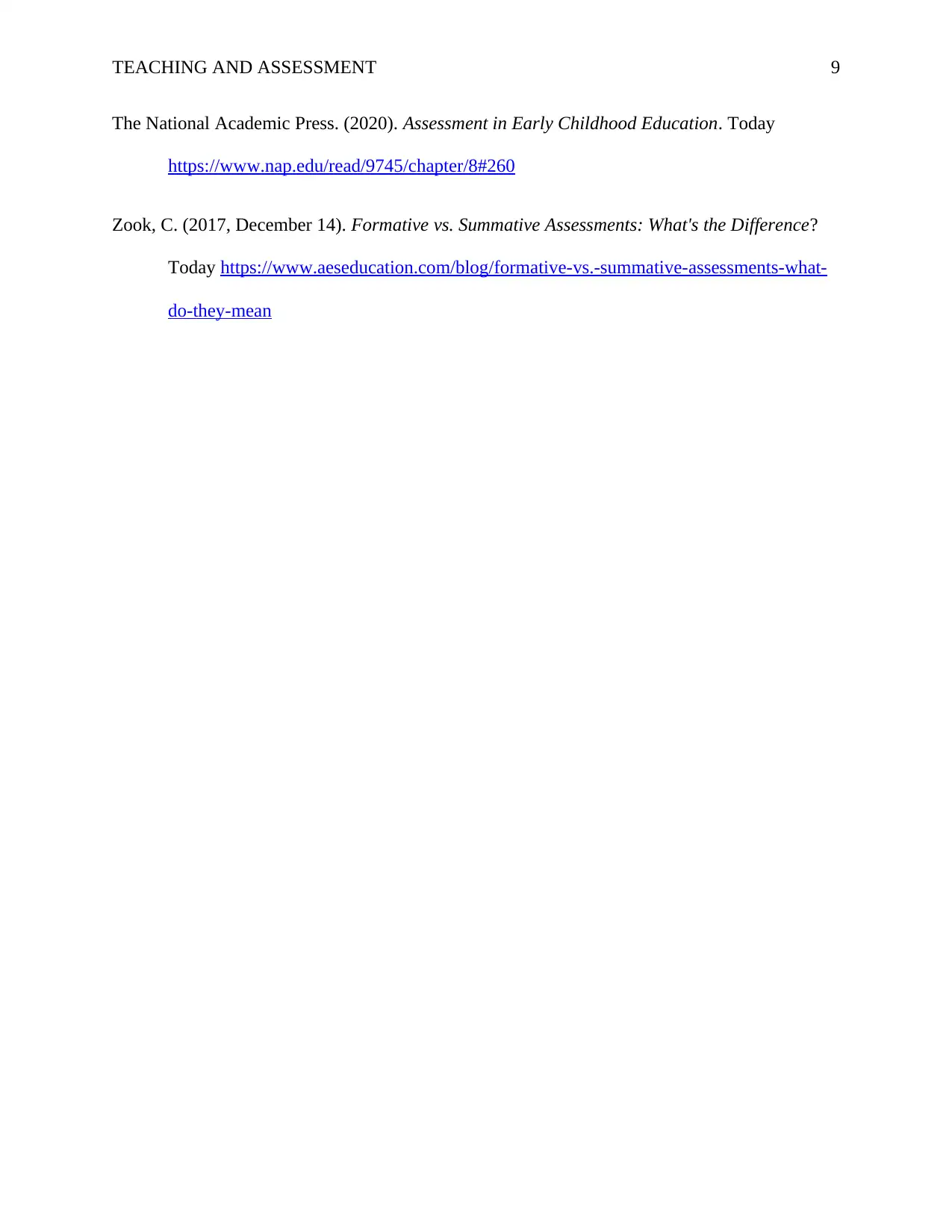
TEACHING AND ASSESSMENT 9
The National Academic Press. (2020). Assessment in Early Childhood Education. Today
https://www.nap.edu/read/9745/chapter/8#260
Zook, C. (2017, December 14). Formative vs. Summative Assessments: What's the Difference?
Today https://www.aeseducation.com/blog/formative-vs.-summative-assessments-what-
do-they-mean
The National Academic Press. (2020). Assessment in Early Childhood Education. Today
https://www.nap.edu/read/9745/chapter/8#260
Zook, C. (2017, December 14). Formative vs. Summative Assessments: What's the Difference?
Today https://www.aeseducation.com/blog/formative-vs.-summative-assessments-what-
do-they-mean
1 out of 10
Related Documents
Your All-in-One AI-Powered Toolkit for Academic Success.
+13062052269
info@desklib.com
Available 24*7 on WhatsApp / Email
![[object Object]](/_next/static/media/star-bottom.7253800d.svg)
Unlock your academic potential
Copyright © 2020–2025 A2Z Services. All Rights Reserved. Developed and managed by ZUCOL.




